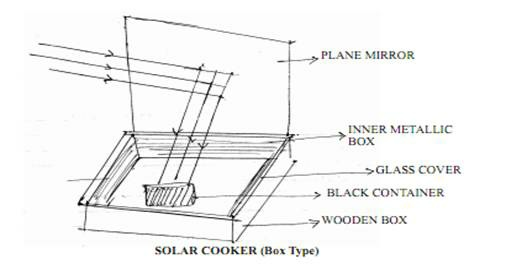
Solar Energy
The energy emitted by the sun in form of heat and light is called solar energy.
Solar Constant = 1.4 (kJ/s.m2)
Outer edge of the earth receives solar energy equal to 1.4 kJ/s.m2 which is known as solar constant.
Solar Energy Devices
A large number of devices that utilize solar energy directly like :
- Solar Cooker
- Solar furnaces
- Solar cells
- Solar water heaters
Solar Heating Devices (Solar Cooker)
- Use black painted surface because black surface absorbs more heat as compared to white or other surface.
- Use of glass plate because it allows shorter wave lengths infrared radiations to enter through it but doesn’t allow the infrared radiations to exit through it, causing more green House effect that results in increase in temperature.

- Use energy which is available in plenty (Solar Energy)
- Is pollution free.
- Cannot be used for frying or baking purpose.
- Food cannot be cooked at night or on a cloudy day.
- Direction of reflector of solar heating has to be changed from time to time to keep it facing the sun.
Solar cells
Solar cells are device that convert Solar energy into electricity. Solar cell develops a voltage of 0.5 – IV and can produce about 0.7 W of electricity.
Advantages of Solar Cell
- Require a little maintenance
- Have no moving part.
- No focusing device is required
- Can be set up in remote areas.
- Environment – friendly i.e. do not cause pollution.
Disadvantage of Solar Cells
- It requires high cost
- Efficiency is low
- Initial cost of installation is quite high.
Uses of Solar Cell
- Used in calculators, watches etc.
- Used in artificial satellites and space probes.
- It is used in radio or wireless transmission system.
Solar Panel
A large number of Solar Cells connected to each other in an arrangement is called solar panel.
Material used for Making Solar Cells
- Silicon
- Silver is used for inter connection of cells.
Energy from the Sea or Ocean (Tidal Energy)
The energy from the sea is available in the following forms:
- Energy of sea waves
- Tidal energy
- Ocean Thermal Energy.
(i) Energy of Sea Waves
- he waves are generated by the strong winds that blows across the sea.
- The kinetic energy of this moving water rotates the turbine of a generator
When strong winds stop blowing, the generator stops producing electricity
(ii)Tidal Energy
The tidal energy possessed by water during tides.
- The tides are caused due to gravitational force of attraction exerted by the moon on the water of the ocean.
- This form of energy is harnessed by constructing a dam across a narrow opening to the sea.
- A turbine fixed at the opening of the dam converts tidal energy to electricity.
(iii) Ocean Thermal Energy
- The power plants used to harness the ocean thermal energy is known as “Ocean Thermal Energy Conversion Plant” (OTEC)
- Temperature difference between surface water and water at the depth of 2km should be 20°C or more.
- The warm surface water is used to boil ammonia (liquid).
- The vapours of the liquid are used to run the turbine of generator.
- The cold water (from deeper layers) is pumped up to condense the vapour into liquid.
Geothermal Energy
- Energy stored as heat inside the earth
- The steam of underground water is taken out by sinking pipes through holes drilled in the earth’s crust. The steam under high pressure is used to rotate the turbines of the generator to produce electricity.
Nuclear Energy
Nuclear energy is the energy which is stored in the nucleus of an atom.
Nuclear energy is of two types
- Nuclear fission: nucleus of a heavy atom (Uranium) when bombarded with low energy neutron split (break down) into lighter nuclei and huge amount of energy is released
- Nuclear Fusion: When two lighter nuclei join up to form heavy nucleus and tremendous amount of energy is released. Nuclear fission process is utilized in nuclear reactors to produce electricity.
- Major Nuclear power plants: Tarapur, Rana Pratap Sagar, Kalpakkam.
Advantages of Nuclear Energy
- Large amount of energy is released.
- In nuclear power plant, the nuclear fuel is inserted once to get energy over a long period of time.
Disadvantages of Nuclear Energy
- High cost of installation.
- Environmental contamination may occur due to improper nuclear waste disposal.
How long will energy source last
Continuous use of non-renewable source of energy is a matter of concern because ultimately the deposit of these sources will be completely finished on the other hand renewable sources of energy will last forever e.g. sun as a source of energy will be available for a very long period of time.

